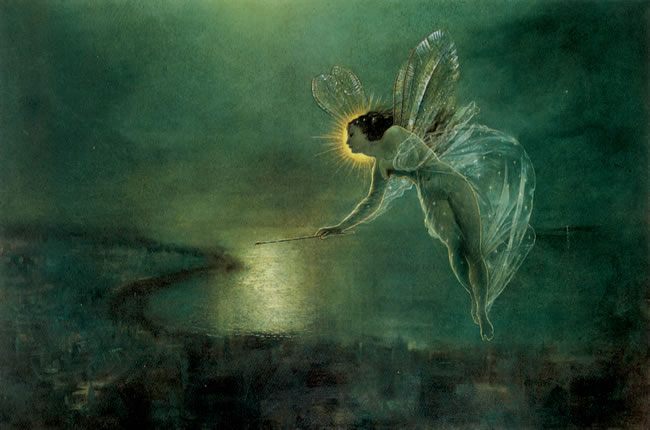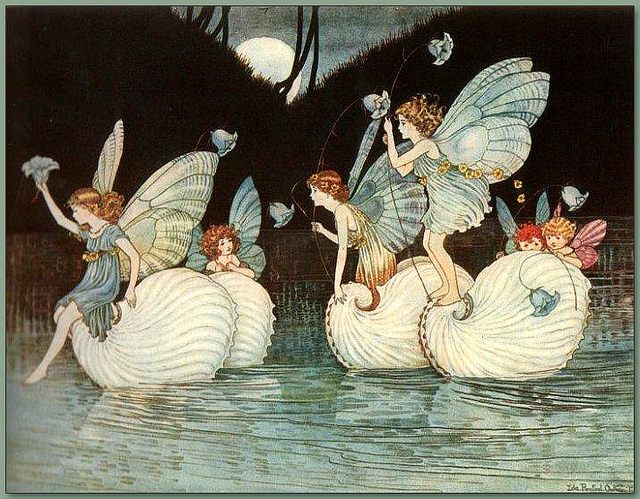The First Global Fairy Census Wants To Hear About Your Close Encounters

John Atkinson Grimshaw’s 1897 painting “Spirit of the Night”. (Photo: Public Domain/WikiCommons)
More than 50 years ago, the Fairy Investigation Society was all but destroyed by a fairy sex scandal of sorts. Now, it’s back, and it’s aiming to complete the world’s first global fairy census.
The FIS was founded in 1927 by Quentin Craufurd, a naval officer who claimed to have invented the wireless telephone. Craufurd had an ongoing interest in spiritualism—he was attempting to contact the spirit world using wireless technology—and one of his friends gave him a copy of artist Bernard Sleigh’s novel The Gates of Horn: Being Sundry Records from the Proceedings of the Society for the Investigation of Faery Fact & Fallacy. The novel described the inner workings of a fictional fairy research organization. Craufurd was so taken with the idea that he contacted Sleigh, and the two founded the FIS together.
The FIS was composed mainly of self-described psychics and “fairy seers,” people who reported some encounters or even ongoing experiences with fairies. But the “investigation” part of the Fairy Investigation Society was not purely passive. In his history of the FIS, historian and current group leader Simon Young described some of Craufurd’s more experimental dealings with fairies:
There is a memory of Craufurd challenging fairies to open flower buds in his garden. Then, in his 1957 retrospective, Craufurd also recalls some experiments he undertook ‘from 1927–32’ with unnamed visitors to his house and with a group of nine marsh fairies. The experiments are not well described. They appear to have involved a fairy seance with a radio set and automatic writing. The fairies would use words from English and Old English and tell their human interlocutors where to look for archaeological remains, which sometimes they even found.
The pre-WWII archives of the FIS are lost, apart from references in Craufurd’s published works. (Craufurd blames “enemy action,” which may mean the London bombings, or perhaps sabotage from the religious groups he claims opposed the society’s work.) But in 1950, the FIS appointed as its secretary Marjorie Johnson, a “fairy seer” and collector of accounts of fairy experiences. With Johnson recording fairy experiences, doing outreach, and generally running things, the society bloomed to around 100 members. Walt Disney was listed on the membership rolls, but it’s unlikely he would have attended meetings on the other side of the Atlantic. Other members included June Kynaston, author of the now-lost book, Nude Dancing for Health.

Charles Sims’ painting “…and the fairies ran away with their clothes”. (Photo: Public Domain/WikiCommons)
The current FIS fairy census has its roots in an unfinished project from this period. In the mid-1950s, Johnson and Scottish folklorist Alasdair Alpin MacGregor started circulating letters requesting accounts of fairy encounters, to be collected in a book. They eventually disbanded their collaboration—MacGregor wanted to travel. The first fairy census, such as it was, was abandoned, but they had already collected plenty of letters detailing personal encounters with fairies. Johnson planned to publish these in a collection called Fairy Vision, which would be a comprehensive discussion of fairies and the people who could see them.
But the first incarnation of the FIS was scuppered by salacious rumor-mongering. A 1960 article about Marjorie Johnson in the Sunday Pictorial announced: “She Does A Kinsey On Fairies.” Fairy Vision, the article claimed, would cover fairy sex, love, and reproduction, including the shocking news that “fairies are bisexual and polygamous, sharing each other’s wives, husbands and children.” More innocently, the book also revealed that fairies don’t get pregnant, but rather reproduce via “wishful thinking.” “It has taken me years of study to win their friendship and discover the secrets of their sex life,” Johnson was quoted as saying. “Anyone who is admitted to the circle of fairy friendship is very fortunate.”
Johnson, whose interest in fairies was not at all prurient, wrote a letter to the editor accusing the paper of “false reporting.” The Sunday Pictorial (now called the Sunday Mirror) is a fairly scurrilous tabloid, so this is probably true—but it didn’t make much difference. The article went the 1960 equivalent of viral. It was syndicated in newspapers worldwide, and journalists started badgering Johnson for interviews. The sensitive and retiring Johnson retreated from her role in the FIS, perhaps unable to cope with all the mocking scrutiny.
British historian Leslie Shepard officially took over as secretary, but without Johnson to run it, the FIS was functionally kneecapped. In her last draft of Fairy Vision—which was eventually published, in 2014, under the name Seeing Fairies and minus any mystical pansexuality—Johnson declared the society “defunct.” That was in the mid-1990s, when she would have been about 85 years old.

An illustration from the 1916 book “Elves and Fairies”. (Photo: Public Domain/WikiCommons)
Now Simon Young, the Fairy Investigation Society historian, is bringing the FIS back, but with an academic twist. “The old FIS was really a theosophist organization, in that to belong you had to believe,” says Young, a folklore researcher who teaches history in Italy. “Today, the big difference is that we are a society of those interested in fairy lore, which includes believers but also many who are not believers.” (Young has described himself as “by nature skeptical about paranormal events.”)
This fairy census, as a project of the new, less dogmatic FIS, isn’t intended to prove the existence of fairies. Rather, it’s meant to collect the reports and experiences of those who believe they’ve encountered one. And there are hundreds of people willing to tell those tales. When Italian folklorist Sabina Magliocco put up her own fairy survey, the reaction was so enthusiastic that she reached her goal of 500 responses in less than a week. Young told me that his census has had hundreds of responses already; he’s aiming for 2,000 by the time the survey closes in 2016.
The census form guarantees contributors that their accounts won’t be published outside the FIS, but subscribers to the newsletter can see a selection of responses. The fairies described there vary greatly in size, aspect, and dress: Four inches, dressed like Robin Hood. Ten inches, wearing Oxford commoners’ gowns. Ten to twelve feet high with a flame-like aura and a pyramid-shaped head. Three feet square and matte bluish-white, like a pillowcase. Twice human height and made of sticks. Pure white light the size of a dragonfly. Blue and Gollum-like, with webbed hands. Six and a half feet tall, with six fingers on each hand. Dark grey hair and skin, black flowered dress, and floating a few feet off the ground. Three feet tall, looking like Santa Claus but with white horns and a bright red face and tail. Tall and thin with a pointed head and wreathed in glowing green mist. A blue horse the size of a dog.
Most of the encounters happened in childhood, but the survey respondents have no apparent doubt about what they’ve seen. They write “I saw,” not “I thought I saw,” and occasionally head off potential objections ahead of time: “I know it wasn’t a dream.” Even the writer who saw butterfly-like iridescent fairies after a series of strokes doesn’t imagine that the experience could have been some kind of neural misfiring. That story concludes: “I believe they healed me from the stroke effects.”
If the census respondents believe in fairies, they’re certainly not alone. There’s also a yearly assembly for fairy believers near Twisp, Washington. Since 2001, the Fairy and Human Relations Congress has been gathering “flower essence specialists, animal and plant communicators, shamanic practitioners and herbalists, wildcrafters, fairy seers, intuitives, geomancers, Bards and Druids, and Native American storytellers” for three days of music, dancing, and group meditation. Marjorie Johnson and the original Fairy Investigation Society would surely approve.
Even with his scholarly and skeptical bent, Young approves too—he wrote in one of the FIS newsletters that he hoped to attend the Congress one day. As a folklorist, Young is interested in the anthropology of fairy beliefs and fairy encounters. “We measure not just the fairies, but the people seeing the fairies,” he told me.
But Young wants to collect many more responses before weighing in on what, if anything, can be said about the people seeing the fairies. If you’ve encountered little men, pyramid-headed giants, dog-sized horses, or anything else out of the ordinary, or know someone who has, consider contributing to the fairy census. You’ll be helping the cause of fairy scholarship, not to mention the legacy of an embattled nearly 80-year-old organization that once attracted the likes of Walt Disney.







Follow us on Twitter to get the latest on the world's hidden wonders.
Like us on Facebook to get the latest on the world's hidden wonders.
Follow us on Twitter Like us on Facebook